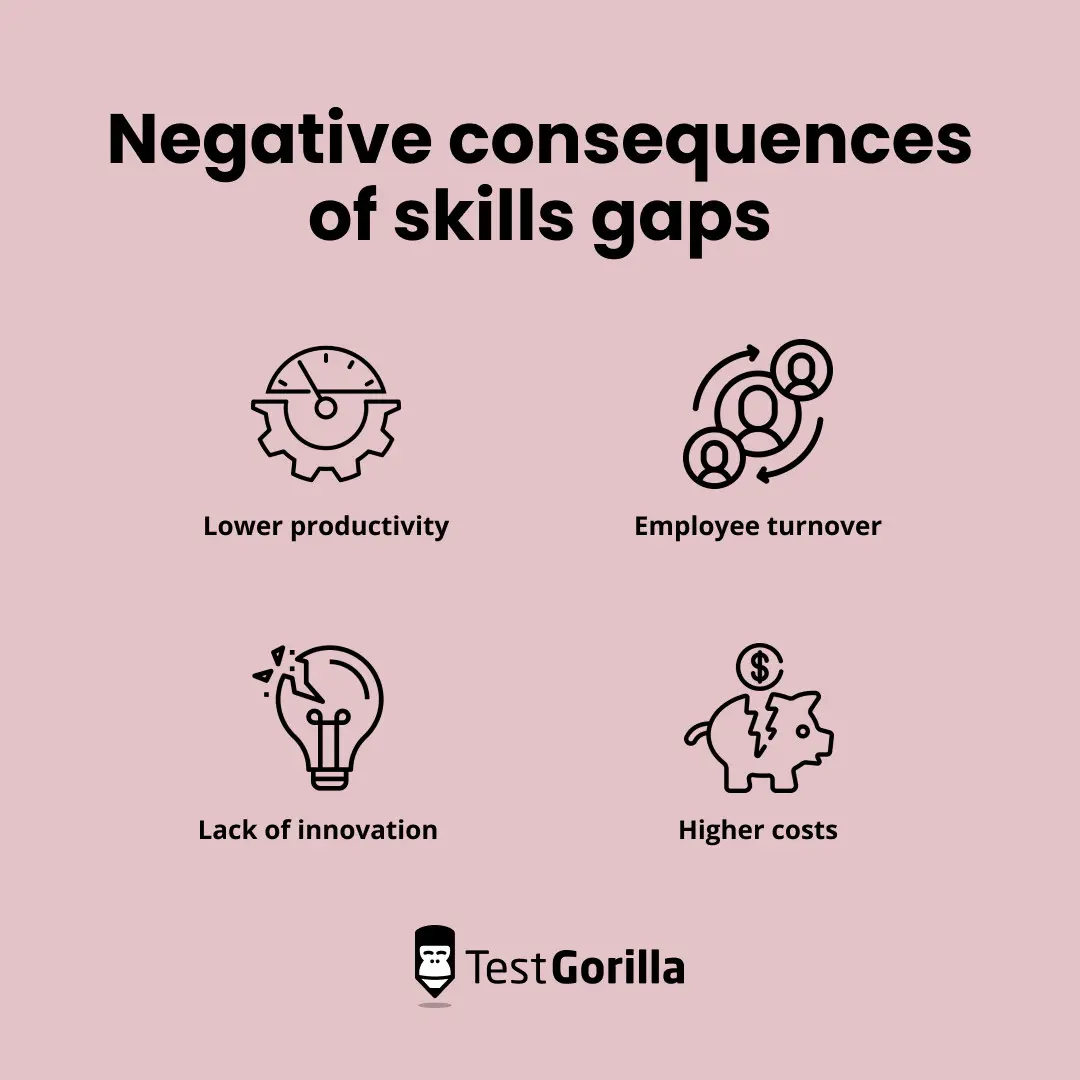As organizations work to keep up with evolving industry demands, advancing technology, and competition, they often find themselves facing skills gaps within their workforce.
A classic example is what we’ve seen during the shift to remote learning, where training firms have had to scramble to find educators proficient with distance learning and eLearning software.
Skills gaps like this can dramatically impact a company’s growth, costing the US economy $13bn monthly.[1]
Organizations dealing with skills gaps experience a negative impact on productivity, innovation, customer satisfaction, and profitability.
Another problem with skills gaps is that they are difficult to identify before they become a problem. Most companies only see their effects… and by then, it’s too late to address them.
The good news is you’re about to learn how to identify and address skills gaps effectively using talent assessments.
Below, we explore how different skills tests help you bridge skills gaps as well as providing you with practical tips and examples on how to use them.
Table of contents
- What are skills gaps?
- The difficulties with bridging the skills gap you’re facing
- How talent assessments help discover and address skills gaps
- 7 ways to use talent assessments for closing the skills gap
- Beyond talent assessments: 3 best practices to remember for addressing skills gaps
- Successfully close the skills gap with talent assessments
What are skills gaps?
A skills gap refers to a mismatch between the skills employers need for their roles and the skills their employees possess. Skills gaps affect both hard skills, such as technical skills or specialized knowledge, and soft skills, such as communication and teamwork.
Skills gaps make it difficult for organizations to fill vacancies, retain skilled workers, and achieve their goals.
So, what causes skills gaps?
Many factors contribute to the formation of skills gaps. This includes:
Lack of qualified candidates
New technologies and digital transformation
Demographic shifts and generational changes
Globalization and competition
Shifts in customer expectations and behaviors
Lack of soft-skill development
Other socioeconomic factors
According to a McKinsey Survey on future workforce trends, 77% of businesses report facing or expecting skills gaps within the next five years.
The same report recognizes the areas where the skills gap has the biggest impact. That includes:
Data analytics
IT, mobile, and web design and management
Executive management
HR and talent management
Sales and marketing operations
Product/service design
Research and development
Front-line management
Customer service
Financial and risk management
Production, manufacturing operations, and engineering
Sourcing, procurement, or supply chain management
The difficulties with bridging the skills gap you’re facing
Many employers struggle to identify skill gaps. Even when they recognize the issue, they still overlook essential transferable skills, often prioritizing hard technical skills over soft skills and culture add.
These difficulties or barriers have negative consequences on organizational performance or outcomes. For example, they can lead to:
Lower productivity or efficiency due to skill shortages and mismatches
Higher employee turnover or attrition due to skill obsolescence and dissatisfaction
Lower quality or lack of innovation due to skill deficiencies and gaps
Higher costs or risks due to skill redundancies and errors
The most common mistake organizations make when trying to bridge the skills gap is relying too much on traditional hiring practices.
Yes, getting more workers with appropriate skill sets is a great way to address these issues – but you need to be careful when depending on a traditional hiring process because its methods are often slow, inefficient, and unconsciously biased.
By focusing primarily on past experience and education via tools like resumes and unstructured interviews, companies unintentionally:
Reduce their available talent pool
Hire for pedigree rather than demonstrable skills
Harm their diversity and inclusivity efforts
This can lead to a vicious cycle of hiring and turnover (a churn and burn culture), which is a major problem when you consider a bad hire costs up to 200% of an employee’s annual salary.[2]
Not to mention that the whole traditional hiring process is time-consuming. Recent research suggests it takes 44 days for companies to fill an open position, including recruiting, reviewing resumes, interviewing, screening, and hiring a new employee.
Let’s look at the alternative.
How talent assessments help discover and address skills gaps
After struggling to find skilled workers during the pandemic, many businesses decided to try something new – forgo degree requirements and adopt a skills-based hiring approach.
According to our survey, 92.5% of organizations saw reduced mis-hires for the role when using skills-based hiring. In addition, 72.1% of employees hired using this method felt happy or very happy in their roles.
Talent assessments are a fundamental part of this new approach.
Talent assessments measure a candidate’s competence, skills, personality, and potential for a specific role or industry.
They include various tests, such as:
Cognitive ability tests
Personality tests
Skills tests
Situational judgment tests
Work sample tests
Job simulations
Talent assessments can be administered online or in person, often through multiple-choice questions or exercises that must be completed within a set time limit.
Talent assessments help companies find and address skills gaps by:
Providing objective and reliable data to evaluate talent capabilities and potential
Accurately identifying missing skills via skill gap analysis
Discovering what skills are needed for the company’s future development
Promoting internal recruitment by discovering employees with transferable skills
Matching the right talent to the right roles based on abilities and personality
Supporting the right training programs to upskill current staff
Shortening time-to-hire
Opening the talent pool and reducing bias in hiring
7 ways to use talent assessments for closing the skills gap
If you’re short on time, here’s a short summary of how talent assessments help organizations effectively address skills gaps:
What talent assessments can do | How this helps close skills gaps |
1. Conduct skill gap analysis | Provide reliable data on existing skill levels and potential within the company |
2. Discover essential skills | Offer insights into role demands and expectations, helping to identify essential skills for specific positions |
3. Upskill employees | Guide skill development efforts, helping employees with setting goals and tracking progress |
4. Create a strategic hiring plan | Identify candidates based on skills and role alignment, promoting hiring efficiency and diversity |
5. Widen the talent pool | Replace traditional resume-based hiring and focus on skill and potential instead of credentials |
6. Create better job descriptions | Provide accurate data to help you develop more effective and inclusive job listings to attract talent |
7. Collaborate with contractors | Temporarily fill skills gaps with contractors by providing data on skills availability, quality, cost, and risk |
Now here are all the details on how to leverage talent assessments to solve talent gaps:
1. Conduct a skills gap analysis
A skills gap analysis is a process of identifying and measuring the difference between the current and desired skills for a company to grow.
A skills gap analysis focuses on the big picture, looking at things from a company-wide perspective rather than at specific employees. This helps organizations prioritize skill needs, set skill goals, and plan skill development actions.
Talent assessments help in conducting a skills gap analysis by equipping you with data on the existing skill level and potential of employees.
Here’s how we suggest you use talent assessments to conduct a skill gap analysis:
Define the scope and purpose of the analysis
Choose the relevant talent assessment tools and methods
Collect and analyze the skills assessment data
Compare the results with the desired skill standards or benchmarks
Identify the skill gaps and their causes and impacts
Communicate the findings and recommendations to stakeholders
Let’s say a B2B SaaS company noticed that its client acquisition rates and revenues were decreasing.
After its HR department conducted a skills gap analysis within the sales department, the company noticed that its salespeople didn’t understand how to use their new digital marketing CRM for lead nurturing – which was affecting their ability to meet quotas.
These insights enabled the SaaS firm to invest in training sessions and, in this way, quickly and effectively overcome a skill gap.
2. Discover which skills are essential
Some companies don’t have a clear scope on which skills are essential for a particular role. That’s because some positions require a diverse and evolving set of skills depending on a number of factors, including the industry, market, strategy, culture, or vision.
Discovering which skills are essential helps organizations align their skill development initiatives with business objectives and values.
Talent assessments help businesses by identifying the core competencies that are necessary for each role and measuring the current and desired skill level of each competency and job.
Let’s say a tech startup started off hiring people based solely on hard skills – like knowing Python – and having experience with established organizations in their industry.
However, the company quickly ran into problems because it failed to recognize the essential soft skills startup employees need to have to thrive in this fast-paced environment.
By using talent assessments, the startup discovered that nurturing problem-solving, adaptability, and innovative thinking is essential to remain agile and thrive.
Because of this, the startup now uses Problem Solving tests and other skills assessments to support recruitment for startups and reduce soft skill gaps.
3. Fill skills gaps by upskilling employees
Upskilling is the process of improving the existing skills or acquiring new skills to support employees’ performance or potential.
Investing in people who are already in your company is crucial for addressing skills gaps because it is often cheaper and more effective than hiring new workers.
Upskilling is also vital for employees – 40% of employees worry their skills will become outdated due to automation, artificial intelligence, and other factors.
Employees realize that acquiring new skills is the only way to thrive in today’s market, which is why 68% state they would stay with their employer if they choose to upskill them.
Unfortunately, 49% of employees want to develop their skills but don’t know how.
Upskilling employees is a strong alternative to hiring new employees because it:
Is cost-effective
Boosts workforce productivity
Supports employee engagement
Improves employee retention
Builds loyalty and motivation
Talent assessments help solve talent shortages and upskill employees by providing feedback and development guidance.
Here’s a short guide on how to use talent assessments to fill skills gaps by upskilling employees:
Identify the skill development goals and objectives for each employee
Choose the appropriate talent assessment tools and methods to monitor and measure the skill development outcomes and impacts
Offer relevant and accessible learning resources and reskilling opportunities to employees based on their development needs and preferences
Use skills tests to monitor progress
Provide regular and constructive feedback and coaching to employees based on their talent assessment results
Recognize and reward employees for their skill development achievements and contributions
4. Support a strategic hiring plan for filling skills gaps
A strategic workforce plan is a blueprint for the recruitment process, outlining criteria, methods, and resources to fill job vacancies.
Talent assessments, when used as the initial screening step, enable organizations to identify respondents based on their skills and alignment with the role.
This approach improves hiring efficiency by reducing time-to-hire, cost-to-hire, and risk. It also promotes equality and diversity in your hiring process.
Retiring employees are among the leading causes of skills gaps.
Instead of accepting these gaps as a natural part of life, businesses should assess what skill gaps are caused by retiring employees and set up initiatives to transfer their expertise and knowledge to other workers. For example, some companies are experimenting with phased retirement to give older workers a chance to stay employed for longer and:
Mentor younger colleagues or new hires
Build robust knowledge repositories
Serve as quality benchmarks for necessary skills and capabilities, which can be used when hiring millennials and Gen Z workers
Here’s how you can use skills assessments for strategic workforce planning:
Define the role profile and job description
Choose the relevant talent assessment tools and methods to screen candidates based on their skills, personality, and culture add potential
Set the cut-off scores or benchmarks for each talent assessment to filter candidates based on their performance or potential
Use the talent assessment results to rank, compare, or shortlist candidates based on skills
Use the talent assessment results to inform the subsequent hiring steps, such as interviews, references, or offers
5. Widen your talent pool
Most companies use resumes to identify specific qualifications, experiences, or credentials candidates must have to be considered for a role or vacancy. However, as mentioned earlier, this approach causes organizations to miss out on hiring quality candidates.
Because of this, many businesses have decided to toss away resumes and focus on skill-based hiring. This approach attracts a broader range of applicants and supports talent diversity and inclusion while mitigating talent bias and discrimination.
But how do companies examine candidates’ skills if they don’t look at resumes?
The answer is talent assessments.
These screening tests make resumes obsolete because they focus on the skills and potential of candidates rather than credentials or backgrounds. This way, a company can confidently employ workers without degrees or with little industry experience.
This empowers you to attract more candidates from different backgrounds, educations, and industries.
You can also use talent assessments to:
Refine the role: Review and revise the role profile to eliminate unnecessary or irrelevant requirements that limit or exclude candidates
Identify transferable skills: Identify candidates with transferable skills, adjacent skills, or hidden skills that are relevant or valuable for the role
Rehire former employees: Check whether previous workers have developed outside of your organization and now these skills could be of value in a new role
6. Build effective, inclusive job descriptions from your skills gap analysis
Traditional job descriptions focus on strict requirements, such as the right education or relevant industry experience.
This can be problematic because not all quality candidates possess the necessary experience or education – they might have built their skills through nontraditional routes.
In addition, job listings may feature language that unintentionally excludes many diverse applicants, contributing to skills gaps.
Talent assessments help you overcome these issues by giving you a clear picture of your hiring needs.
Look back to your skills gap analysis and focus on the hard and soft skills that you’re missing – and that are required for succeeding in the role.
This data-driven approach ensures a more transparent and accurate representation of each job and attracts more qualified, diverse candidates.
Here are a few ideas for leveraging data from skills assessments and skills gap analysis to create better job descriptions:
Use clear and concise language to describe the responsibilities, requirements, benefits, and expectations of the role
Include positive and inclusive words to describe the culture, values, or vision of the organization
Add data-driven terms to describe the impact, scope, and opportunities of each role
7. Temporarily fill skills gaps with contractors
Hiring a contractor to address temporary skills gaps serves several strategic purposes.
It enables organizations to promptly meet urgent or short-term skill needs, access specialized or niche skill sets, improve flexibility and scalability, and reduce overhead costs and potential liabilities.
Let’s say a healthcare institution needs to implement a new health electronic record system. Its employees don’t possess the necessary skills, so the organization hires contractors.
This ensures immediate access to necessary skills, helping the healthcare organization improve patient data management while reducing potential risks in the process.
In short, talent assessments help hire contractors by providing reliable data on their skills, which increases hire quality and reduces the costs and risks traditionally associated with contingent workers.
Here’s to use talent assessment to quickly bridge skill gaps with contractors:
Define the scope, duration, budget, and deliverables of the project or assignment that requires contractors
Choose relevant talent assessment tools and methods to screen contractors based on their skills, personality, and culture add potential
Set the contract terms and conditions based on the talent assessment results and the project requirements
Manage and monitor the contractor’s performance and feedback based on the talent assessment results and the project outcomes
Beyond talent assessments: 3 best practices to remember for addressing skills gaps
Although talent assessments are crucial for overcoming skills gaps, they are only one piece of the puzzle. To tackle the skills gap effectively, companies need to adopt a comprehensive approach that combines various strategies and actions.
That’s because skills gaps often occur (or get worse) when organizations fail to recognize opportunities to innovate and develop their workforces.
Here are the three most important practices that complement talent assessments in preventing and bridging the skills gap:
1. Build a great employee training and development program
Well-rounded employee training programs and leadership development plans are vital to creating a business environment that fosters growth.
However, research shows that 45% of middle-market companies don’t have an ongoing training program. Even worse, 61% don’t even have a system for internal career advancement, and only 30% of businesses partner with other organizations to provide employees with necessary training and education.
Considering how 51% of employees planning to quit list lack of growth opportunities as the number one reason, you can see why employee training and development programs are so important.
So, how do you build a great employee training and development program?
Here are some things you can focus on:
Focus | Tip |
Alignment with business goals Ensure learning objectives align with necessary skills for organizational success. | Use talent assessments to tailor training to individual needs. |
Diverse learning formats Offer varied learning methods for accessibility and flexibility. | Incorporate online materials, blended, or micro-learning options. |
Feedback and recognition Motivate and recognize your employees to sustain a culture of continuous learning. | Foster a culture of feedback and ownership for better skill development. |
Outcome evaluation Measure the impact of training on skill development and performance. | Use metrics and analytics to estimate the ROI of training initiatives. |
2. Determine your company’s short- and long-term goals
If you want to identify and address skill goals effectively, you must have a clear vision of where your company is headed and what it aims to achieve. To do that, you need to determine your short- and long-term goals and create a strategic framework.
Here’s how to define your organization’s goals:
Perform SWOT analysis: Conduct a SWOT analysis to evaluate your company’s strengths, weaknesses, opportunities, and threats. This step provides valuable insights for aligning goals with market dynamics and your workforce’s current skills.
Tip: Use talent assessments to evaluate the current competencies and potential of your employees to align with goals and opportunities.
Focus on SMART goals: Set specific, measurable, achievable, relevant, and time-bound (SMART) goals for your organization. This ensures clarity, accountability, and progress tracking.
Tip: Break down long-term goals into smaller milestones and action plans to keep the employees focused and motivated.
Ensure stakeholder commitment: Communicate the defined goals to all stakeholders, ensuring alignment and commitment from leadership, employees, managers, and external partners.
Tip: Involve employees in goal-setting and decision-making processes to support ownership and engagement.
Perform regular review and adaptation: Continuously review and adapt goals based on changing circumstances and feedback.
Tip: Use dashboards and reports to monitor progress and performance, ensuring that goals remain realistic and achievable.
3. Hire for transferable skills
Transferable skills can be applied across different roles, industries, or contexts. That mainly includes soft skills, such as communication, teamwork, problem-solving, and creativity.
Here’s why transferable skills help companies overcome skills gaps:
Wider talent pools: Technical skills are in high demand but short supply in many industries. By focusing on transferable skills, you can tap into a broader talent base. Just remember to set aside time and budget to train new hires on the hard skills that they will require.
Tip: Seek candidates with diverse backgrounds, experiences, or interests that show transferable skills. They bring fresh perspectives and adaptability to the workplace.
Increased resilience and adaptability: Transferable skills, like communication, teamwork, and problem-solving, are good signs of adaptability and resilience. This makes them valuable assets for navigating new technologies and market conditions.
Tip: Use talent assessments to discover candidates’ transferable skills alongside job-specific skills.
Better performance and collaboration: Employees with strong transferable skills tend to perform better, collaborate more effectively, innovate, and contribute to higher levels of customer satisfaction.
Tip: Ask behavioral or situational questions to evaluate how candidates use their transferable skills in different scenarios. For instance, you can ask about a time when a candidate had to adapt to a challenging situation.
Excellent for high-volume hiring situations: Prioritizing transferable skills is vital for high volume hiring, such as seasonal recruitment. These skills ensure that employees can quickly adapt and excel in diverse roles.
Tip: Provide clear new employee onboarding and training programs for high-volume hires to help them swiftly transition and succeed in their roles.
Successfully close the skills gap with talent assessments
Talent assessments are crucial for bridging skills gaps because they enable you to take a data-driven approach to identify and address employee skill deficiencies before they become a major issue for your organization.
This, in turn, empowers you to focus on developing your workforce’s skill sets and hiring the right employees, ultimately improving productivity, talent retention, and financial growth.
To begin bridging the skills gap in your company, we suggest using our Training and Development test to find experts who can support your talent development initiatives.
For more insight on how to address skills gaps in your organization, explore our article on how adjacent skills can help you solve skills gaps.
Sources
“The Costs of Avoiding a Skills Gap Analysis”. TalentGuard. Retrieved October 28, 2023. https://www.talentguard.com/blog/the-costs-of-avoiding-a-skills-gap-analysis
Eaton, Bec. (January 29, 2023). “Why Traditional Recruitment Processes No Longer Cut It – And How Job Simulations Can Help”. Vervoe. Retrieved October 28, 2023. https://vervoe.com/why-traditional-recruitment-processes-no-longer-cut-it/
Related posts
Hire the best candidates with TestGorilla
Create pre-employment assessments in minutes to screen candidates, save time, and hire the best talent.
Latest posts
The best advice in pre-employment testing, in your inbox.
No spam. Unsubscribe at any time.

Hire the best. No bias. No stress.
Our screening tests identify the best candidates and make your hiring decisions faster, easier, and bias-free.
Free resources
This checklist covers key features you should look for when choosing a skills testing platform
This resource will help you develop an onboarding checklist for new hires.
How to assess your candidates' attention to detail.
Learn how to get human resources certified through HRCI or SHRM.
Learn how you can improve the level of talent at your company.
Learn how CapitalT reduced hiring bias with online skills assessments.
Learn how to make the resume process more efficient and more effective.
Improve your hiring strategy with these 7 critical recruitment metrics.
Learn how Sukhi decreased time spent reviewing resumes by 83%!
Hire more efficiently with these hacks that 99% of recruiters aren't using.
Make a business case for diversity and inclusion initiatives with this data.




















